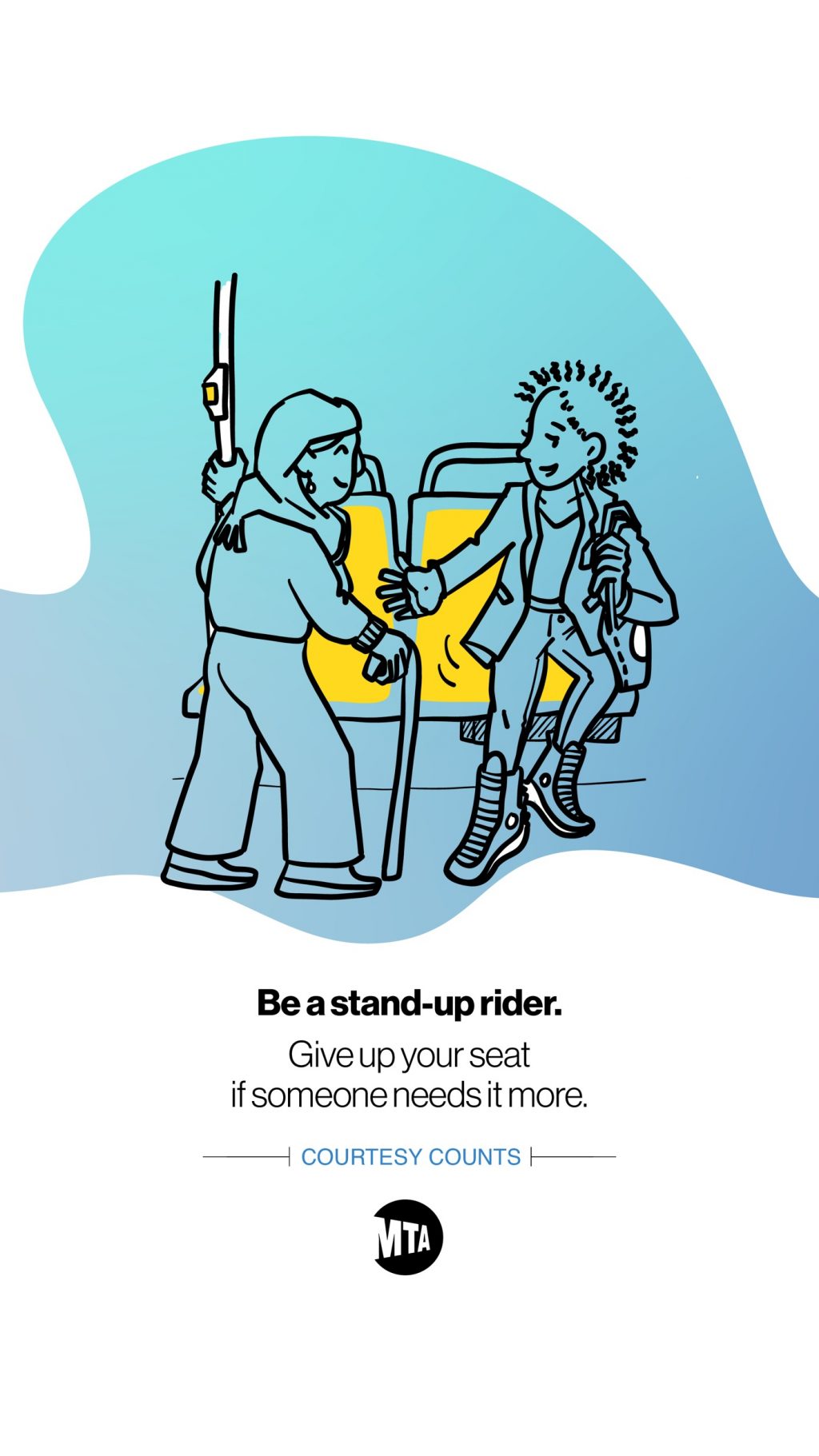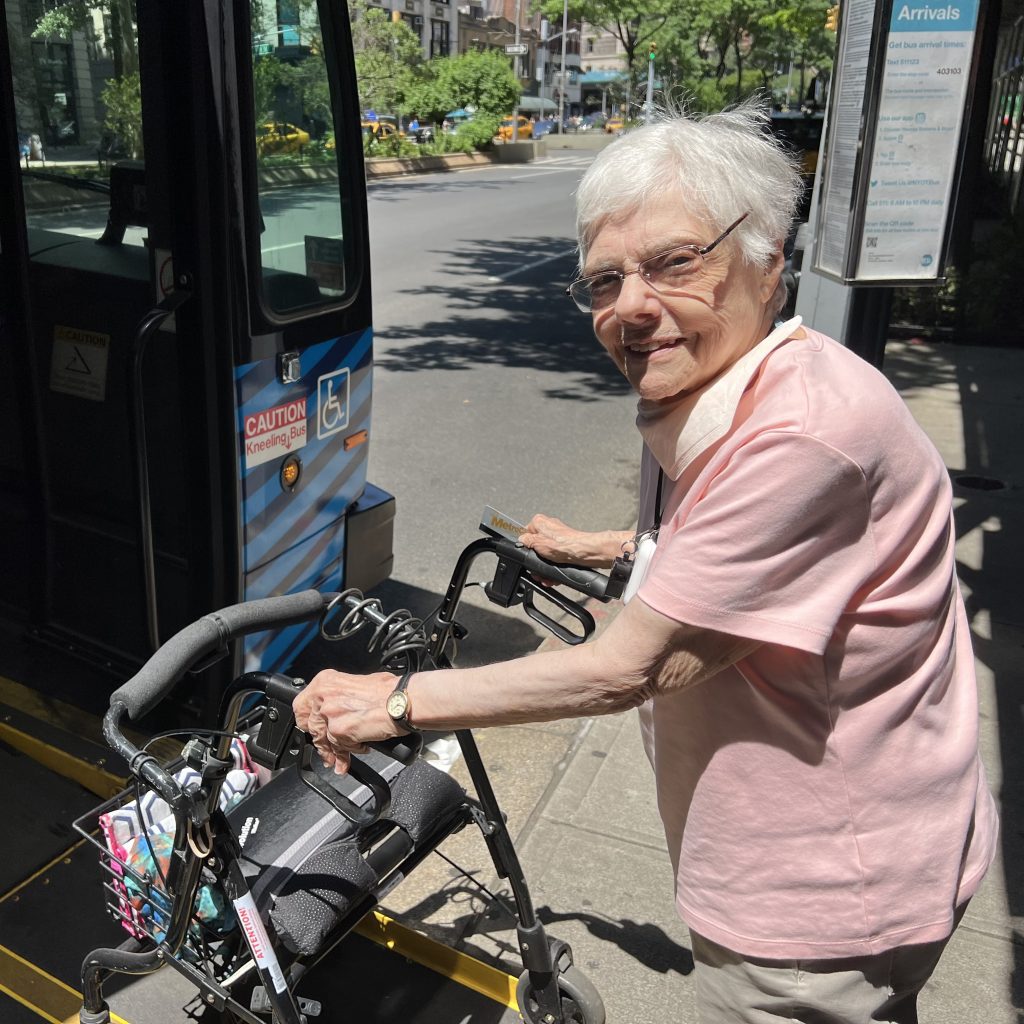Lea Anastasio uses a walker and rides the M104 all the time. She’s also a fan of the M57, M72, and M5. Just the other day, she got on the kneeling ramp of the M104 at the bus stop located between 73-74th Streets and Broadway in front of the entry to the Apple Bank Residences at 2112 Broadway.
Another passenger, a young mother and her two children in a stroller were pleased for the convenience, and an elderly man was as well, when the driver let them use the ramp.
Lea was riding to 83rd Street and Broadway to buy a new printer at Staples. A long-time Upper West Sider, Lea had a first career as a logistics analyst at ABC. Then, in pursuit of a professional change, she earned a Master’s degree in Social Work at Fordham and went on to a job at New York- Presbyterian Columbia University Irving Medical Center on West 168th Street. As a social worker, she worked with patients and clinicians in nearly every other service. “It was very rewarding work,” she said. “The more you benefit others, the more you get.”
Today, still living on West 71st Street after four decades, she uses MTA buses very frequently to go to medical appointments, meet up with her niece or friends, or go to the museums. She doesn’t let reliance on a walker hold her back. She values the accessibility of NYC buses very much because she leads an active life. “My only complaint,” she confided, [is] “When I take the M57 back from my doctor, it’s usually in the afternoon when the bus is full of kiddos, and none of them ever offers me a seat. If anyone does, it’s a much older people.”
Beyond appreciating the convenience of buses for getting from one place to another, Lea also gets a kick out of interacting with fellow passengers. She surprises them with pointed comments and her quick wit. Told that she’s an interesting person, Lea responded, “You have to be interesting when you’re old, or you’re invisible.”
 Enjoying her neighborhood as much as her rides to various parts of the city, two of Lea’s favorite local restaurants are Felice on Columbus and Cafe Luxembourg off Amsterdam.
Enjoying her neighborhood as much as her rides to various parts of the city, two of Lea’s favorite local restaurants are Felice on Columbus and Cafe Luxembourg off Amsterdam.
The MTA was ahead of many other cities in making bus transportation accessible. Joana Flores, an MTA spokeswoman, noted that “The MTA first purchased buses with wheelchair lifts in 1981, nine years ahead of the 1990 Americans with Disabilities Act.”
MTA Chief Accessibility Officer Quemuel Arroyo, who uses a wheelchair, said, “The MTA’s 5,800 bus fleet has been fully accessible for three decades, providing reliable, accessible transportation to every part of the five boroughs, “We continue to make our buses easier to use, with more flexible seating, wider doors and ramps, and an open stroller area that helps improve everyone’s trip.”
It’s shocking to think that buses, like many public facilities, were once inaccessible to people with disabilities. Even today, there are passengers and drivers who express their annoyance about the time it takes to accommodate people with a disability.
One bus driver did not mince his words about complainers in a blog post relating to bus service giving priority to wheelchair passengers. In a 2009 post on NYCtransitforums.com, a MTA bus driver commented,
I don’t care if passengers stand on each others’ shoulders. I will accommodate a wheelchair passenger without regard to the inconvenience of other passengers who can stand on their own two feet. The policy is: If a person with a wheelchair or, walker needs to board, the operator will make room at the designated wheelchair seating area in the bus and secure that passenger. The operator will ask what the destination is and if the stop is obstructed, curb the bus at the most safe spot nearest the bus stop.
Aware of issues related to courtesy, Joana said, “There are multiple signs on the bus on this very matter, and back in October 2023, the MTA launched a “Courtesy Counts” campaign to remind riders of courteous behavior as ridership continued to climb. A slide from that campaign includes an image focused on giving up your seat to someone who needs it more.

 By
By